Basalt Rustyhood
Basalt RustyhoodPterostylis basaltica | |
|---|---|
| Kingdom: | Plantae |
| Phylum: | Magnoliophyta (Angiosperm) |
| Class: | Magnoliopsida (Monocotyledon) |
| Sub-class: | Liliidae |
| Order: | Orchidales |
| Family: | Orchidaceae |
| Status | |
| World: | |
| Australia: | Endangered (EPBC Act 1999) |
| Victoria: | Critically endangered (FFG Threatened List 2023) |
| FFG: | listed, Action Statement No. 137 |
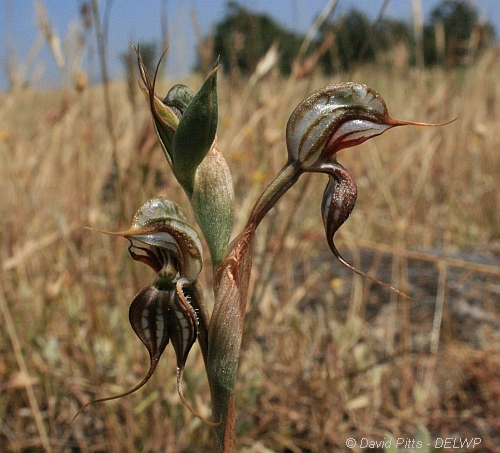
The Basalt Rustyhood (also known as the Basalt Greenhood) was only described in 1993 (Jones & Clements 1993). It is regarded as being one of the most threatened orchids in Australia and is endemic to the south-west of Victoria.
Flower stem grows to 30cm tall with 3-5 closely sheathing stem leaves. It has up to fifteen flowers 1.5cm in length, which are translucent with prominent green or greenish-brown stripes. Between 8 to 15 dull green basal rosette leaves (30mm long by 10mm wide) are closely arranged at the base of the plant, they are more pronounced during the non-flowering period and usually withered by the time of flowering.
Distribution
The Basalt Rustyhood is only known from two locations in close proximity to each other in the Dundonell area of the Victorian Volcanic Plains bioregion.
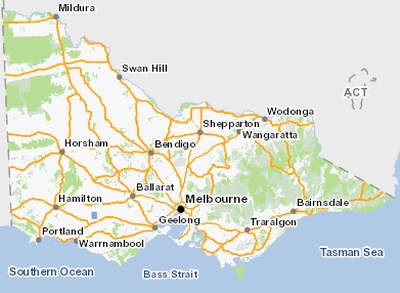
All known records of Basalt Rustyhood. Source: VBA 2015
Ecology & Habitat
The Basalt Rustyhood grows in a 500-700 mm rainfall area on 'stony rises' on the western basalt plains. It is found on shallow, sometimes bare, soil surrounded by basalt rocks occurring in native grasslands containing Kangaroo Grass Themeda triandra and Common Everlasting Chrysocephalum apiculatum. The orchid's new growth commences in late summer to early autumn and the rosette of the orchid actively grows from May to October. Flowering takes place from November to January subject to seasonal conditions. Small flies or fungus gnats carry out pollination.
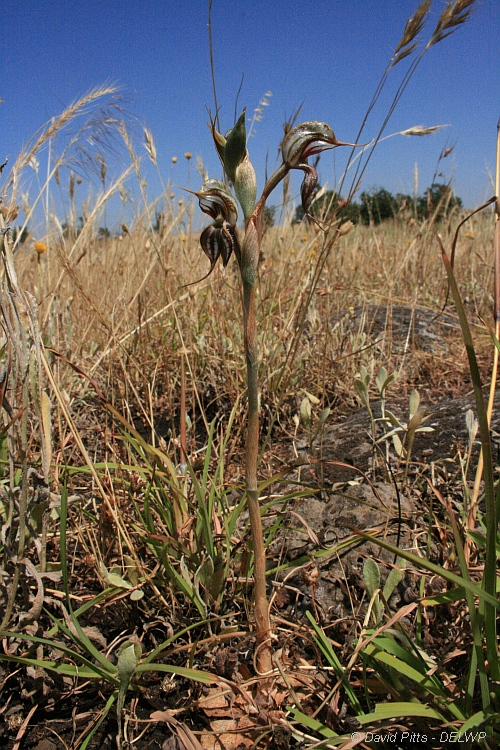
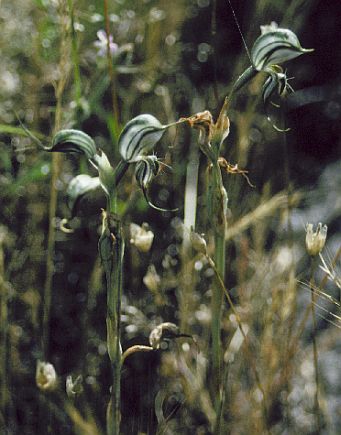
Basalt Rustyhood. Image: Yvonne Ingeme
Threats
At present there are no known populations in conservation reserves which means close co-operation with private land holders and the Moyne Shire is required to ensure the long term viability of this species.
Weed invasion is considered a major threat to the Basalt Rustyhood, particularly as it grows in such a limited ecological niche, which includes sparse ground cover that can be easily occupied by weedy species. Physical disturbance to soil in and around the population has the potential to increase weed invasion. Broad scale spraying near these populations may increase in the presence of weeds and result in loss of the population. Particular care needs to be taken with roadside works and the movement of stock in the area. Grazing by rabbits may impact on the success of flowering and development of seed. Genetic isolation and limited natural pollination may also have longer-term consequences.
Conservation & Management
The conservation status of Basalt Rustyhood was re-assessed from Endangered in 2014 to Critically Endangered in 2020 as part of the Conservation Status Assessment Project – Victoria (DELWP 2020). This species is now listed as Critically Endangered in Victoria and across Australia under the Flora and Fauna Guarantee Act 1988 - Threatened List - June 2021 (DELWP 2021).
Detailed population monitoring of the site has occurred since 1996 and land managers are aware of the delicate state of the population.
Moyne Shire, volunteer groups, including Land Protection volunteers, the Australian Native Orchid Society, International Student Volunteers, Country Fire Authority and landholders have also assisted with the recovery of this species by taking part in roadside surveys, monitoring and maintenance.
Bi-annual monitoring involves collecting information on the number of plants present, number of pollinated plants, number of flowering plants and seed pod development.
Hand pollination has been use to successfully produce viable seed as natural pollination rates are very low. seed has been collected and stored in the Victorian Conservation Seed Bank at the Royal Botanic Gardens.
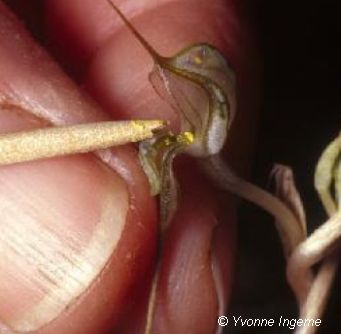
Hand pollination of Basalt Rustyhood is undertaken to increase the success of producing viable seed.
Specific conservation measures
- Conduct research to determine the specific ecological requirements for natural regeneration, and investigate mycorrhizal fungi associations.
- Determine the genetic health and viability of the remnant populations.
- Establish and facilitate a local Recovery Team.
- Investigate the feasibility of, and options for, establishment of new populations of Basalt Rustyhood at secure sites.
- Provide information and advice, including maps, regarding the location and management of Basalt Rustyhood sites to landholders, land managers and other authorities, especially Catchment Management Authorities and local government authorities.
- Identify habitat requirements of the pollinator.
- Identify ecological tolerances of the species.
Private Property site
Continue to monitor populations, collecting information on total number of plants, number of flowering plants and pollination success/seed pod development.
Protect key private land populations in cooperation with landholders, possibly through a formal area agreement.
Dundonell roadside site
Develop and implement a weed control plan for this site. This will involve a full evaluation of the weed flora on the site as well as an evaluation of all weed management options, taking into consideration the species involved, population sizes, locations, proximity to the orchids, etc.
Establish photo points at the site to provide useful information on recruitment success and orchid development. A monitoring protocol, specifically dealing with this site, the Basalt Rustyhood and other ''Pterostylis'' populations will also be prepared to ensure protection of the populations whilst undertaking monitoring.
Liaise with CFA over fire management issues.
Continue to monitor populations, collecting information on total number of plants, number of flowering plants and pollination success/seed pod development.
Undertake hand pollination.
Collect seed for propagation by Royal Botanic Gardens.
Projects & Partnerships
Updates on outcomes of seed collection and propagation.
2016
- It is planned that the Royal Botanic Gardens Melbourne will propagate plants for re-introduction.
2015
- Continued efforts by DELWP in conjunction with landholder to manage and or restore microhabitat on the private property site by grazing to achieve biomass reduction.
2014
- Weed control undertaken to reduce biomass at the private property site.
- All population monitoring datasets on the roadside area were collated and assessed to gain an accurate account of the population size and health.
- Monitoring undertaken -8 flowering plants detected in the long-term monitoring plot in November 2014.
2013
- Weed control undertaken to reduce biomass at the private property site.
- Annual monitoring of roadside site completed.
2012
- An ecological burn was applied by the CFA to the Basalt Rustyhood population on the Woorndoo - Dundonell Road.
- The monitoring protocol used in 2011 was implemented in July 2012, leaf and flower was monitoring undertaken by DSE biodiversity officers, Australian Native Orchid Society volunteers and Woorndoo Landcare. 175 re-emergent rosettes were recorded, 53 of which managed to flower in November 2012.
- The presence of Avena barbata (Wild Oats) throughout the remnant population of Basalt Rustyhood orchids was observed in 2012. This is of concern and has required hand removal of Wild Oats near orchids to prevent them from being smothered.
- New infestations of the highly invasive Tall Wheat-grass (Thinopyrum poticum) several hundred meters to the west of the Basalt Rustyhood population were treated.
2011
- DSE biodiversity officers, CFA Vegetation Management Officer and Moyne Shire Municipal Fire Prevention Officer had discussions to plan fire prescriptions for important roadside areas.
- A program for ex-situ propagation of Basalt Rustyhood was undertaken through the Orchid Conservation Program which is a partnership between the Royal Botanic Gardens in Melbourne and DSE.
- Population monitoring conducted in 2011 by DSE threatened flora staff and members of the ANOS will provided valuable pre-burn information on the population and will hopefully provide an important account of this species post fire response.
2010
- In October 2010, Phalaris, Tall Wheat Grass and other environmental weeds were treated at important Basalt Rustyhood roadside sites. This weed control work was followed up with a second treatment in January 2011.
- In November 2010 Basalt Rustyhood monitoring was undertaken at the only known location by DSE Biodiversity Officers, with assistance from members from the Hamilton Field Naturalists Group and the Australian Native Orchid Society. A total of 84 plants were recorded.
2009
- Basalt Rustyhood seed collected and stored in RBG seed bank.
- Monitoring found no plants at the private property site.
References & links
Australian Government, Biodiversity Species Profile and Threats Database Pterostylis basaltica Basalt Greenhood
Backhouse, G. and Jeanes, J. (1995). The Orchids of Victoria. Melbourne University Press, Carlton, Victoria.
DELWP (2021) Flora and Fauna Guarantee Act 1988 - Threatened List - June 2021, Department of Environment Land Water and Planning, Victoria.
DELWP (2020) Provisional re-assessments of taxa as part of the Conservation Status Assessment Project – Victoria 2020, Department of Environment Land Water and Planning, Victoria.
DEPI (2014) Advisory List of Rare Or Threatened Plants In Victoria - 2014 Department of Environment, Land, Water & Planning Victoria
DSE (2003) Flora & Fauna Guarantee Action Statement No.137 Basalt Greenhood, ''Pterostylis basaltica'', Department of Sustainability & Environment, Victoria. Action Statement No.137 Basalt Greenhood pdf.
FFG Threatened List (2023) Department of Energy, Environment and Climate Action (DEECA).
Ingeme, Y., Backhouse, G. (1999) Basalt Greenhood (Pterostylis basaltica) Recovery Plan 2000-2004 Department of Natural Resources and Environment, Melbourne.
Jones, D.L. & Clements, M.A. (1993). New Species of Pterostylis. R.Br. (Orchidaceae) from Victoria and New South Wales. Muelleria 8 (1) 73-83. National Herbarium of Victoria.
VBA (2015) Victorian Biodiversity Atlas, Department of Environment, Land, Water & Planning, East Melbourne, Victoria. Accessed October 2015.
Vlcek, K and Pritchard, A. (2010) National Recovery Plan for Basalt Rustyhood Pterostylis basaltica. Department of Sustainability and Environment, East Melbourne. National Recovery Plan for Basalt Rustyhood Pterostylis basaltica
Walsh, N.G. & Entwisle, T.J. (1994) Flora of Victoria, Volume 2 - Ferns and Allied Plants, Conifers and Monocotyledons. Inkata Press, Melbourne.

